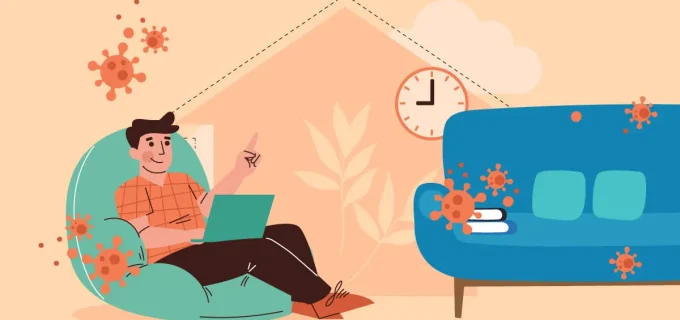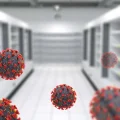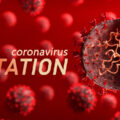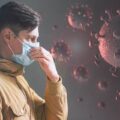After more than 35 years in the business of professional cleaning, decontamination, disaster response, sanitation, and disinfection within Singapore and the South East Asian Region, it should come as no surprise that the technical professional and technical advisors at ‘Big Red’ possess a wealth of experience and technical expertise. As such, their opinions are often sought when complex infection control risks arise that need a very high level of professional knowledge and capability to address.
With the emergence of a new variant strain of the Coronavirus (COVID-19) in the UK, a strain that is thought to be at least 71% more contagious than the original virus, many people have asked our resident team of professionals for advice on how best to keep themselves and the Citizens of Singapore safe and healthy from this much more contagious strain of the virus. One area of concern that has been highlighted by these inquiries is the role that upholstery, textile, and fabric surfaces, and coverings might play in both harboring and then transmitting the virus to other people via a process of cross-contamination and onward re-infection. Therefore, ‘Big Red’ has asked Prof. Martin A. Blake, their resident Preventive Medicine and Public Health Advisor to share his views on the associated nascent risks and the most appropriate infection control strategies to be adopted.
Absolute and Likely Risks with the New Variant COVID-19 Strain
From a truly global perspective, after living (and sadly, in many cases dying) with the COVID-19 virus, the empirical studies, epidemiological studies, laboratory investigations, clinical trials, and day to day healthcare have led to the Coronavirus being the most studied virus in the history of mankind. Therefore, there is a global plethora of scientific evidence on how the virus is actually transmitted from person to person and place to place. There is no doubt at all that when an individual contracts COVID-19, irrespective of whether they present as symptomatic or asymptomatic, they will begin to shed and spread millions and millions of highly infectious viral particles whenever they breathe, talk, sneeze, cough, sing or shout. Once released into the air or onto any porous or non-porous surfaces, there is a tangible, proven risk of onward re-infection either by the inhalation of airborne viral particles or via cross-contamination via objects and surfaces. Only two weeks ago, just prior to the new variant strain of the COVID-19 being identified, Prof. Martin A. Blake ‘Big Red’s’ resident Preventive Medicine and Infection Control specialist stated:
“It has become very clear over the last twelve-months that the Coronavirus (COVID-19) is a highly contagious, virulent infectious disease and it is extremely capable of both direct and indirect transmission, hence its rapid spread from country to country, place to place and person to person. It’s propensity to spread so easily is the distinguishing factor that has enabled it to move from a single city in China to become a global pandemic. Therefore, wherever there is a possibility that a particular surface might harbor the COVID-19 virus, it is prudent that we should take all the necessary steps to eliminate any viral load that we know might be lingering somewhere as a potential reservoir of disease transmission”
Earlier this week, following the emergence of the new dominant strain of COVID-19, Prof. Blake reiterated his earlier warnings and with an addendum as follows:
“Only a couple of weeks ago, I pointed out the latent risks of cross-contamination and onward infection by this highly contagious, virulent virus that has become infamous by its ability to spread with significant ease from place to place and person to person and notorious by its ability to make people very sick and in two million cases, go on to kill them. Therefore, the emergence of a new more contagious variant of the COVID-19 virus needs to be treated very, very seriously indeed. This new variant has already been shown to be more than 70% more contagious than the original strains. Therefore, if we needed to be careful, vigilant, and diligent before, now we need to ‘raise our game’ even further and leave (almost literally) no stone unturned in destroying all traces of this virus, wherever it may hide and linger, waiting to infect its next innocent victim”
Unfortunately, this new dominant strain is not just a little more contagious than its predecessors but has already shown that its introduction into any given community will probably increase that community’s ‘R Number’ by an average of 0.5 above the previous prevailing reinfection rate. Whilst precise empirical scientific data is still emerging, this new strain of COVID-19 virus has become more transmissible by a process of mutation as follows:
- Positive individuals with the more contagious strain of the COVID-19 virus will shed significantly larger numbers of infectious viral particles
- Paradoxically, because this strain of the virus is more contagious, a lower viral load is actually required for re-infection
- This new strain of the virus remains airborne and thus, potentially more infectious for longer
- Similarly, this new dominant viral strain can also remain infectious on objects and surfaces, including upholstery, textiles and fabric covered surfaces for longer periods of time
Last week, based on these recent developments, the increased transmissibility of the new more contagious variant strains Prof. Blake of ‘Big Red’ added:
“Immediate action needs to be taken by other countries around the world, as transmission and infection by this new genetic strain of COVID-19 is right now, a real tangible risk, not a perceived risk. It would be incredibly foolish to assume that this highly infectious variant of the virus has been successfully contained within the United Kingdom and that it has not already spread by air-travel to other parts of the world where it will also, just like in the UK, become the dominant more dangerous variant of the disease.”
Since making that statement last week, the virus has now been identified as the emerging dominant strain in several other European countries as well as in Sydney, Australia. So, it is clear that the new variant of this deadly virus is literally (and metaphorically) already ‘in the air’ and possibly traveling to a space near you, which is why, all spaces that we choose to occupy, including upholstery, textiles, and fabric-covered surfaces require an even more rigorous cleaning and disinfection protocol to be adopted.
Infection Control Overview
From a cleaning and disinfection perspective, the actual basic principles of hygiene and infection control regarding this more infectious strain of the COVID-19 virus remain the same: ‘Clean – Kill – Protect – Maintain’. However, because the virus is now more easily transmissible and thus more contagious, we just need to follow these basic, integrated principles more thoroughly, more diligently and more often.
Principle One: ‘Clean’ – Preparatory Pre-cleaning and Sanitising
Most people are now already aware that the COVID-19 virus is very easily spread by airborne transmission and this particular strain even more so. Therefore, even if there is a small chance that the fabrics and materials in question may have become contaminated, it is essential that the chances of the virus being re-launched back into the air are minimized. This can be accomplished in the following ways:
- Do not vacuum the fabrics and materials in question. It is important not to cause unnecessary agitation or disturbance that could cause contagious viral particles becoming launched into the air again and actually increasing, not decreasing the risk of transmission and onward infection.
- Instead of dry-vacuuming, before disturbing any fabrics or materials, first damp them down slightly with a light misting of an appropriately diluted sanitizing agent. Suitable agents can be found within the EPA’s List N: Disinfectants for Use Against SARS-CoV-2 as all the disinfectants included on this list have been certified to be effective in destroying the COVID-19 virus.
Once the damping down process has been completed, all small pieces of fabric that can be machine washed should be carefully contained within plastic bags and sent to the laundry for washing in accordance with the manufacturer’s instruction, but wherever possible, on the highest temperature setting possible. All larger pieces of upholstery or surfaces covered with textiles and fabrics that cannot be laundered should once be damped down be treated in accordance with the remaining three principles.
Principle Two: ‘Kill’ – Destroy the Virus ‘in-situ’ Wherever it Might be Hiding
According to the team at ‘Big Red’ there are two methods that can be effectively used to disinfect upholstery, fabrics and textiles in order to completely destroy the pathogenic organisms that they might be harboring, including the COVID-19 virus. The choice between the two preferred methods, depends entirely on the characteristics of the material in question, but this very simple algorithm will determine the correct choice:
A. Is the upholstery, fabric or textile in question suitable for ‘High Temperature Steam Extraction Shampooing’; ‘Yes’ or ‘No’? If the answer is ‘Yes’ then this is the technology of choice!
B. If the answer to ‘A’ above is ‘No’ then disinfection with a nebulised and ionically charged solution of hydrogen peroxide is the technology of choice! Now we can examine both of these technologies in turn.
High-Temperature Steam Extraction Shampooing: While the upholstery, fabrics, and textiles are still damp from their pre-treatment with an approved sanitizing agent, they should then be subjected to a thorough process of high-temperature steam extraction cleaning which as advised by Prof. Blake at ‘Big Red’ is the preferred way of killing any bacteria and viral particles that might still be concealed within the fabric of the materials themselves. In addition to the scalding moist heat generated in the process, ‘Big Red’ also recommend augmenting the cleaning and disinfection process with a disinfectant/detergent shampoo that is included within the EPA’s ‘N List’ as this potent combination of moist heat and disinfectant will destroy all pathogenic organisms immediately upon contact.
Nebulised and Ionically Charged Hydrogen Peroxide: For any upholstery, fabrics, or textiles that cannot be subjected to high temperatures or the physical process of steam cleaning and extraction, then the alternative recommended by ‘Big Red’ depends on the structure of the very fabric itself being penetrated by a highly pervasive nebulized, ionically charged vapor of Hydrogen Peroxide.
This application method known as ‘BRMist’ is extremely efficient and can deliver what is known as a 6 Log Kill by instantaneously killing 99.9999% of all pathogenic organisms that may be present, and which actually renders the material effectively ‘sterile’.
However, irrespective of which of the above two choices are selected, Prof. Blake of ‘Big Red’ further states that all such treatments can only guarantee that the upholstery, fabrics and textiles will remain totally free from onward transmission risk up until the next COVID-19 positive individual shedding contagious viral particles re-contaminates them again. This is why, ‘Big Red’ also advocates a further step of long-term residual antimicrobial protection.
Principle Three: ‘Protect’ Against Recontamination with a 24/7 Antimicrobial Surface Treatment
Once the upholstery, textiles, and fabrics in question have been pre-treated and then disinfected in accordance with Principle One and Two they can for the moment (with the operative word being ‘moment’) be considered completely risk free in terms of still being a potential reservoir of contagion and onward infection only until such time as they become re-contaminated again. This is because no matter how clean and sterile the materials and fabrics have become, all standard disinfectants have no residual antimicrobial properties at all, and therefore, as soon as another COVID-19 positive individual enters the space, whilst shedding huge numbers of contagious viral particles, the situation returns, by default to the same level of risk as before. Therefore, ‘Big Red’ also firmly advocates a further step in the process, by treating all surfaces within the area (both porous and non-porous) with a residual, long-lasting antimicrobial surface protection treatment such as ‘BRShield’ which is capable of delivering total, ongoing protection from viral re-contamination and onward infection on a 24/7 basis for 180 days following the application.
‘BRShield’ is an organo-silane formulation, that is capable of chemically bonding to all surfaces (including upholstery, textiles, and fabrics) at the molecular level and once bonded, provides all treated surfaces with semi-permanent, broad-spectrum, antimicrobial properties. Once endowed with the ongoing power to kill new ‘inbound’ viral particles (as well as all other pathogenic microbes) immediately upon their arrival, the surfaces can remain classified as a ‘zero-risk’ of contagion and infection for some considerable time. In fact, ‘Big Red’ is so confident of this that they offer a guarantee of 24/7 protection for at least 180 days from the date of treatment. Finally, once this third step in the process has been completed, ‘Big Red’ suggests that only basic housekeeping is required throughout that 180-day period.
Principle Four: ‘Maintain’ with Ongoing Routine Housekeeping
In order to maintain the treatment in an optimal condition for infection control purposes only minimal ongoing routine maintenance is required to keep the ‘BRShield’ efficiently energized and thereby remain effective and efficient in destroying all inbound pathogenic microbes. The following housekeeping protocol is recommended for all treated areas:
- Vacuum regularly to prevent dust, debris, and detritus degrading the ability of ‘BRShield’ to kill pathogens.
- Additionally, it is better to use a vacuum machine fitted with a HEPA filter so that all debris, no matter how small is safely captured and not recirculated back into the air.
Conclusion
As is usually the case with Preventive Medicine issues, there is no such thing as a ‘one-stop-shop’ in cleaning, killing, and protecting against disease transmission, instead, it requires a carefully coordinated approach as described above.
Two weeks ago, ‘Big Red’ (who have over thirty years of technical and professional experience in disinfection, sterilisation and infection control within Singapore and the surrounding Region) published two short articles providing practical advice on how (in light of the emergence of a new variant of the Corona virus) upholstery, textiles and fabric covered surfaces should be cleaned, sanitised and disinfected and thereby prevent them from becoming reservoirs of infection and onward disease transmission.
Following the publication of these two informative Coronavirus updates on the potential impact of the new COVID-19 strains ‘Big Red’ have been overwhelmed with requests for additional updates, information and guidance to ensure that all surfaces, including non-porous surfaces such as upholstery, textiles and fabric covered surface can be appropriately treated. In response to this unprecedented demand for updated Coronavirus information, the team at ‘Big Red’ have asked their own expert in Public Health and Infection Control, Professor Martin A. Blake, to answer the more Frequently Asked Questions in this third and final part of this series.
Question: How does the new strain of the Covid-19 virus contaminate upholstery, textiles and fabric covered surfaces?
Answer: The new strain of the Coronavirus (COVID-19) is transmitted in all the same ways as the previous dominant strain, so when a person becomes ‘COVID-19’ positive they will, irrespective of whether they are symptomatic or asymptomatic, begin to shed huge numbers of highly contagious viral particles. In particular, they will liberate infectious material from their pulmonary tract, whenever they breathe, talk, cough, sneeze, shout or sing. These infinitesimally small viral particles will then remain suspended in the air, especially indoor air currents, for prolonged periods of time. However, despite their small size and buoyancy, they will eventually settle downwards and then become deposited on all surfaces and objects present within the environment in question which will include upholstery, textiles and fabrics. These highly contagious viral particles will remain viable until they are either transmitted somewhere else and cause re-infection or they die and disappear naturally over time. Therefore, it is in this interim period, between being deposited and dying that these highly infectious viral particles act as a potential reservoir of infection.
Q: How long can the virus survive once deposited in upholstery, textiles and fabric covered surfaces before it dies naturally?
A: The science regarding the longevity of early strain of Coronavirus (COVID-19) is now well proven. It is clear that once shed by its current host, the virus can exist for periods of time extending between a few hours or in some cases, several days. Whilst there is no empirical evidence just for upholstery, textiles and fabric covered surfaces, it is very clear that the virus can survive for a lengthy period of time once arrives and therefore represents a significant risk to other people by onward transmission. However, whilst there is no evidence to suggest that the new strain can survive longer, this is an overwhelming raft of scientific evidence to suggest that the new strain is much more transmissible, infectious or contagious!
Q: Has the COVID-19 virus mutated?
A: Yes, it has! As the virus has been exposed to ‘adaptive pressure’ it has mutated slightly to become much more transmissible which means it is far more contagious and infectious than previous strains of the virus.
Q: Does the new COVID-19 variant cause more serious disease?
A: There is no scientific evidence to suggest that the new dominant strain of the Coronavirus identified in the UK is actually any more, or any less virulent than its predecessor. However, there is a compelling level of scientific evidence to suggest that the new strain of COVID-19 is simply much more adept at spreading from person to person and place to place.
Q: Is the new COVID-19 variant from the UK more deadly?
A: As opposed to the answer given for the question above, whilst this new strain of the virus may not cause a more serious condition in any individual infected, it is much more efficient at spreading and therefore, infecting much larger numbers of people which, in turn, will lead to an elevated mortality rate which, by definition makes it statistically more deadly.
Q: Based on the current knowledge of the new strain of COVID-19, what needs to be done differently in terms of cleaning, sanitising, disinfection and sterilisation to mitigate the risk of contagion and onward disease transmission?
A: Because the new strain of the Coronavirus is at least 70% more contagious in nature than its predecessor, from the perspective of cleaning, sanitation and disinfection, the fundamental principles of public health and preventive medicine remain exactly the same: ‘Clean – Kill – Protect – Maintain’. However, because the virus is now much more easily transmitted and thereby is much more infectious, we now need to adhere to these basic, fundamental principles of hygiene more diligently and more often.
Q: What is now the highest risk of transmission with the new UK strain of COVID-19 compared to the previous strain and where should people focus their attention for maximum efficacy?
A: Because the new strain of COVID-19 is more transmissible (by up to 70%) than its predecessor, the highest risk of contagion (apart from airborne transmission) that can mitigate the risk of infection is by eliminating the presence of the virus on surfaces and objects that can act as vehicles of infectious disease transmission. Therefore, in addition to even enhanced levels of routine cleaning and disinfection protocols, the additional use of a long-term antimicrobial surface treatment will successfully mitigate the risk of onward transmission between the traditional disinfection cycles. In this regard, the team at ‘Big Red’ would advocate the use of ‘BRShield’ which can provide this extended level of antimicrobial protection on a 24/7 basis for up to 180 days.
Q: In your professional opinion, because of the need to adopt an integrated cleaning and disinfection regime should this cleaning and disinfection service be outsourced and who is the most experienced and trusted contractor in SE Asia to undertake all the tasks outlined above?
A: Due to the elevated levels of risk, ‘yes’ I would advocate the use of a professional cleaning and disinfection service contractor and in terms of who I would personally recommend, I can only answer that by emphasising that I have personally chosen to work with ‘Big Red’ in Singapore as they meet my own very high standards of professionalism.
Related posts:
- New Strain of Virus – Same Cleaning and Disinfection Protocols?
- COVID 19: Cleaning and Disinfecting Protocols
- How to Leave Coronavirus Behind When You Come Home
- How to Clean and Disinfect Your Home: Limiting Coronavirus Exposure





